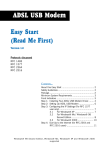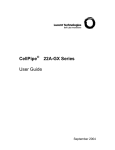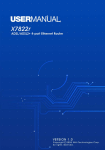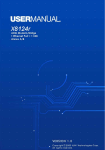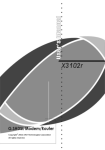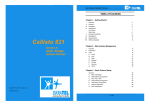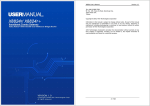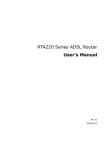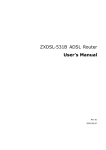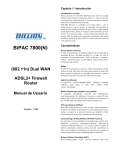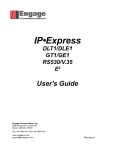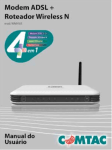Download X7028r User`s Manual Version 2.0
Transcript
X7028r User’s Manual Version 2.0 -1- X7028r User’s Manual Version 2.0 XAVi Technologies Corporation Tel: +886-2-2995-7953 9F, No. 129, Hsing Te Road, Sanchung City, Taipei Hsien 241, Taiwan (R.O.C.) Copyright © 2003, XAVi Technologies Corporation Information in this manual is subject to change without notice. No part of this manual may be reproduced or transmitted in any form or by any means, electronic or mechanical, including photocopying or scanning, for any purpose, without the written permission of XAVi Technologies Corporation. XAVi Technologies Corporation provides this documentation without warranty of any kind, implied or expressed, including, but not limited to, the implied warranties of merchantability and fitness for a particular purpose. -2- X7028r User’s Manual Version 2.0 Table of Contents Chapter 1 – Getting Started I. Overview………………………………….…………………… 7 II. Features…………………………………………………….…. 8 III. Packaging………………………………………….…….……. 9 IV. Safety Guidelines…………………………………………… 10 V. Appearance……………………………………..…………… 11 Front Panel…………………………………………………….. 11 Rear Panel……………………………………………………… 12 VI. Hardware Installation……………………………………….. 13 VII. Management………………….……………………..…….… 14 VIII. Default Values…………….……..………………………….. 15 IX. Software Upgrade……………………..……………………. 16 X. Console Setup……….………………………………....…… 17 Chapter 2 – Web Management Interface I. II. Overview………………….…………………….….…………17 Preparation……………….…………………….…………….17 1. Login………………….…………………………………. 18 2. Status………………….………………………………… 19 3. Statistics……………………………………………..….. 21 4. System……………………………………………..……. 23 4.1 Users……….………………..………….………….. 25 4.2 Error Log…………………………………..……….. 27 4.3 Update…………………………………………..….. 27 4.4 Restart………………….…………………..………. 28 5. Configuration……………………………………….…... 29 5.1 Save Config………………………………………... 29 5.2 LAN Connections………………………………….. 30 5.2.1 Create New Service…………..………….. 30 5.2.2 Change Default LAN IP……..……………. 31 5.3 WAN Connections………………………………… 33 5.3.1 RFC 1483 Routed…………………….…... 33 5.3.2 RFC 1483 Bridged………………..………. 34 5.3.3 PPPoA Routed……………………….…… 35 -3- X7028r User’s Manual Version 2.0 Table of Contents 5.3.4 MER…………………………………..…….. 36 5.3.5 IPoA………………………………………… 37 5.3.6 PPPoE………………………..……………. 38 5.4 Routing Table……………………………………… 40 5.5 DHCP Server………………………….…………… 41 5.6 DNS Relay…………………………………………. 43 5.7 Security…………………………………..….………44 5.8 IGMP Proxy………………………………………… 50 6. Interfaces………………………………………………...51 6.1 Wireless……………………………………….……. 52 6.2 Switch Hub…………………………………………. 53 6.3 ADSL……………………………………………..… 54 Appendix A – Specifications A1. Hardware Specifications..…………………………………...…….. 55 A2. Software Specifications……….…………………………….……... 56 Appendix B – Warranties B1. Product Warranty………………………………..…………………. 57 B2. Warranty Repair………………………………….……………….… 58 B3. Out-of-Warranty Repair. ………………………….………..……… 58 Appendix C – Regulations C1. FCC Part 15 Notice………………………………………………… 59 C2. IC CS-03 Notice……….……………………………….…………... 60 Contact Information……………………………………………………... 61 -4- X7028r User’s Manual Version 2.0 Note: This equipment has been tested and found to comply with the limts for a Class B digital device, pursuant to part 15 of the FCC Rules. These limits are designed to provide against harmful interference in a residential installation. This equipment generates, uses, and can radiate radio frequency energy. If not installed and used in accordance with the instructions, this device may cause harmful interference to radio communications. However, there is no gurantee that interference will not occur in a particular installation. If this equipment does cause harmful interference to radio or television reception, (which can be determined by switching the equipment on/off) the user is encouraged to try to correct the interference by one or more of the following measures: o o o o Reorient or locate the receiving antenna Increase the separation between the equipment and the receiver Connect the equipment into an outlet on a circuit different from that of the receiver. Consult the dealer or an experienced radio/TV technician for help. You are cautioned that any change or modifications to the equipment not expressly approved by the party responsible for compliance could void your authority to operate such equipment. -5- X7028r User’s Manual Version 2.0 Revision Marks Revision V2.0 Date May 14, 2003 Notes Annex A Software Version: 5.06XAF0.AWR Annex B Software Version: 5.06XAF0.BWR -6- X7028r User’s Manual Version 2.0 Chapter 1 Getting Started I. Overview X7028r is multi-mode ADSL router, which complies with ANSI T1.413 issue 2, ITU G.992.1 Annex A/B and ETSI ITS 101388 ADSL Standards. X7028r provides high-speed Internet access via one WAN port over ATM over ADSL, and also connects to a corporate network via four 10/100BaseT Ethernet ports and one 802.11b WLAN for LAN users. -7- X7028r User’s Manual II. Version 2.0 Features High Speed Asymmetrical Data Transmission on Single Twisted Copper Pair Full rate operations up to 8Mbps downstream and up to 1Mbps upstream. G.lite operation up to 1.5Mbps downstream rate and 512Kbps upstream rate. Four 10/100BaseT Ethernet ports for PC or LAN connection HP auto-MDIX detects and corrects crossover cables Service provider can deploy ADSL rapidly over existing wire infrastructure (POTs or ISDN line) 802.11b WLAN support up to 11Mbps DHCP server supported for easy LAN IP address management Support PPPoE (RFC2516), PPP (RFC2364), and IP (RFC 2225/RFC1577) over ATM over ADSL RFC2684 (RFC1483) Bridged/Routed for both LLC/VC MUX Allows LAN users to access Internet through Network Address Translation (NAT, IP sharing) simultaneously Local OAM&P through command line interface via RS-232 Craft port Configuration and management by local Telnet and WEB Browser through the Ethernet interface and remotely through ADSL interface Firmware upgradeable through TFTP -8- X7028r User’s Manual III. Version 2.0 Packaging This package consists of the following items: X7028r ADSL Router RJ-45 Cable RJ-11 Cable AC Adapter User’s Manual CD-ROM -9- X7028r User’s Manual IV. Version 2.0 Safety Guidelines In order to reduce the risk of fire, electric shock and injury, please adhere to the following safety guidelines. Carefully follow the instructions in this manual; also follow all instruction labels on this device. Except for the power adapter supplied, this device should not be connected to any other adapters. Do not spill liquid of any kind on this device. Do not place the unit on an unstable stand or table. This unit may drop and become damaged. Do not expose this unit to direct sunlight. Do not place any hot devices close to this unit, as it may degrade or cause damage to it. Do not place any heavy objects on top of this unit. Do not use liquid cleaners or aerosol cleaners. Use a soft dry cloth for cleaning. - 10 - X7028r User’s Manual V. Version 2.0 Appearance Front Panel 1 2 3 4 5 Label Status 1 PWR/ WAN ON 2 LAN 1 ON 3 LAN 2 ON 4 LAN 3 ON 5 LAN 4 ON Color Orange Green Green Orange Green Orange Green Orange Green Orange - 11 - Description Power adapter is properly connected. ADSL line is connected. 100M data transfer 10M data transfer 100M data transfer 10M data transfer 100M data transfer 10M data transfer 100M data transfer 10M data transfer X7028r User’s Manual Version 2.0 Rear Panel 1 1 3 2 4 Label Description PWR DC-inlet for AC adapter 2 Wireless LAN AP slot 3 1X ~ 4X Four RJ-45 ports for LAN connections 4 WAN RJ-11 ADSL port - 12 - X7028r User’s Manual VI. Version 2.0 Hardware Installation 1. Connect one end of the ADSL cable into the WAN port of the ADSL modem, and the other end into the ADSL wall outlet. 2. Connect one end of the RJ-45 cable into one of the RJ-45 ports of the ADSL modem, and the other end into your PC or LAN. 3. Plug in the AC adapter into the AC power socket, and connect the DC jack into the PWR inlet of the modem. 4. Use a 9-pin RS-232 cable to connect the Console cable to the RJ-45 cable then to a PC with data terminal emulation software (Hyper Terminal) installed, in order for local management. 5. Gently slide the Wireless Access Point (AP) into the WLAN slot. 3 5 4 2 1 Wireless AP Power Socket Management - 13 - PC ADSL Wall Outlet X7028r User’s Manual VII. Version 2.0 Management Console Port – use the RS-232 cable for connecting X7028r to a console terminal or a PC running a terminal emulation program, such as Hyper Terminal. (For further details, See Chapter 1: X Console Setup) Local Ethernet Port (Telnet) – connect the Ethernet port to your local area network or directly to a PC, “Telnet” X7028r from any workstation in the LAN. The default local Ethernet IP address is “192.168.1.1”. Local Ethernet Port (Web Browser) – connect the Ethernet port to your local area network or directly to a PC. Launch your web browser and enter default local Ethernet IP address “192.168.1.1” into the address bar. ADSL Port from Remote Site – while the ADSL connection is in service, you may remotely “Telnet” X7028r from a workstation connected to the CO equipment. Note: As operating an ADSL device requires technical know-how and experience. It is recommended that only qualified technical staffs manage X7028r. Therefore, a password authentication is required when you enter the web interface. See the Default Values section to obtain the password. - 14 - X7028r User’s Manual VIII. Version 2.0 Default Values X7028r is pre-configured with the following parameters; you may also re-load the default parameters by selecting System – Update in the web interface. (For further details, see Chapter 2: 4.3 Update) Default Mode: Bridge Username/Password: admin Bridge Mode Setting WAN and ADSL Ethernet (local) IP: 192.168.1.1 Local Line Code: AUTO Subnet Mask: 255.255.255.0 Trellis Mode: Enable Full Duplex: Disable FDM Mode: Fdm Protocol: RFC1483, Bridge Mode Coding Gain: Auto VPI/VCI: 8/35 Transmit Power Atten: 0dB Class (QoS): UBR Spanning Tree: Disable Packet Filter: Any - 15 - X7028r User’s Manual IX. Version 2.0 Software Upgrade You may easily upgrade X7028r embedded software by obtaining the compressed upgrade kit from the service provider then following the steps: Extract the ZIP file for updated firmware Connect X7028r via the local Ethernet port or remote ADSL link, make sure that the X7028r Ethernet IP address and your terminal are properly configured so that you can successfully “ping” X7028r. The default local IP address is 192.168.1.1. Under the DOS prompt, execute the command “xupgrade <IP address of X7028r>”, for instance “xupgrade 192.168.1.1”. This upgrading process may last as long as 60 seconds. Then reboot X7028r with new software. Note 1: The X7028r software may also be upgraded through the web interface. See Chapter 2: 4.3 Update Note 2: Strictly maintain stable power to the X7028r while upgrading its software. If the power fails during the upgrading process, contents in the memory could be destroyed, and the system may hang. In such as case, you must call the dealer or system integrator for repairs. - 16 - X7028r User’s Manual X. Version 2.0 Console Setup Connect the RS-232 console port to an ASCII data terminal or a PC with Widows serial Terminal mode of VT-100 (Hyper Terminal). To Start the Hyper-terminal, follow the steps below. 1. Start "Hyper-terminal" program -On Windows 98 or Windows NT: Click on the Start button Programs Accessories Hyper Terminal Group Double Click “Hypertrm.exe” Enter Connection Name Select Icon Click OK 2. Select COM port to communicate with the modem Choose direct to COM1 or COM2 and click OK 3. Set Port Properties -Port Setting: − Bit per second: 9600 − Data bits: 8 − Stop bits: 1 − Parity bits: None − Flow Control: None Settings: − Function, arrow, and ctrl keys act as: Windows keys − Emulation: Auto-detect − Back-scroll buffer lines: 500 ASCII Setup: − Echo typed characters locally − Line delay: 0 milliseconds − Character line feeds incoming line ends: enable - 17 - X7028r User’s Manual Version 2.0 Chapter 2 Web Management Interface I. Overview The Web management is provided in order to manage the ADSL device as easily as possible. It provides a very user-friendly configuration and graphical interface through a web platform. You may configure a bridge or a router function to accommodate your device need. In the section below, each configuration item will be described in detail. II. Preparation 1. Please refer the hardware installation procedure in Chapter 1 to install X7028r. 2. You should configure the PC to the same IP subnet as X7028r. Example: The X7028r: 192.168.1.1 Your PC: 192.168.1.x 3. Connect your PC to the X7028r and make sure that the PING function is working properly. The default IP address of this device is 192.168.1.1 4. Launch the Web browser (IE or Netscape), and enter the default IP address 192.168.1.1 into the address bar to access the web management page. 5. The Enter Network Password dialog box will popup first. - 18 - X7028r User’s Manual Version 2.0 1. Login The window Enter Network password will pop up while starting the configuration. With the window active, type admin for both the User Name and the Password. You can also edit the Username and Password or add a new profile. (See section 4.1 Users for further details) - 19 - X7028r User’s Manual 2. Version 2.0 Status The Status page displays the current configuration of the X7028r. You can click on the shortcuts from the Status page for quickly editing most frequent configurations: Click WAN Settings… to edit/add WAN connections refer to section 5.3 WAN Connections for further details. Click LAN Settings… to edit the default LAN IP address refer to section 5.2 LAN Connections for further details. Click Login Settings… to edit the login type refer to section 5.5 DHCP Server for details. Click IP Address Settings… to edit/add WAN connections refer to section 5.3 WAN Connections for further details) Click DHCP Server… to edit DHCP Server status refer to section 5.5 DHCP Server for details. - 20 - X7028r User’s Manual Version 2.0 - 21 - X7028r User’s Manual Version 2.0 3. Statistics The Statistics page displays the current interfaces of the X7028r. Click on the appropriate Show Statistics link to view the statistics of that interface. Three examples are listed below, two for the LAN IP’s and one for Rfc1483-c-0. - 22 - X7028r User’s Manual Version 2.0 Example 1: LAN IP Show Statistics (Wireless) This page displays the current statistics of the wireless LAN (wlan) port. This includes port name, connection status, speed, and transfer/receive packets. You may edit the default LAN port by clicking on the Configure LAN Connections button. (For instructions on how to configure LAN connection, See 5B Configuration – LAN connection) - 23 - X7028r User’s Manual Version 2.0 Example 2: LAN IP Show Statistics (Ethernet) This page displays the current statistics of the Ethernet port. This includes port name, connection status, speed, and transfer/receive packets. You may edit the default LAN port by clicking on the Configure LAN Connections button. (For instructions on how to configure LAN connection, refer to section 5.2 LAN connections) - 24 - X7028r User’s Manual Version 2.0 Example 3: RFC1483-0 Show Statistics This page displays the current statistics of the default bridge RFC 1483. This includes port name, VPI/VCI values, transfer/receive packets and encapsulation type. You may edit/add WAN connections by clicking on the Configure WAN Connection button. (For instructions on how to configure LAN connection, refer to section 5.3 WAN connections) - 25 - X7028r User’s Manual Version 2.0 4. System The System section includes Users, Error Log, Update, Backup/restore and Restart links. Each link is described in detail below. 4.1 Users Click on the Users link on the navigation bar to view the list of users. By default, only the admin user exists. Click on the Edit User… link to change the settings of the admin user. On this page you may change the password and comment of the admin user. Click on the Apply button when completed. - 26 - X7028r User’s Manual Version 2.0 Click on the Create a new user… link to add a new user. On this page you need to enter a username, password, select true or false, if you would like this user to have configuration rights, and add a comment. Click on the Create button when completed. You will then notice that the user has been added to the table. - 27 - X7028r User’s Manual 4.2 Version 2.0 Error Log Click on the Error Log link in the navigation bar to view the history of errors. Click on the Clear Logs button to clear the log table. 4.3 Update Click on the Upgrade link on the navigation bar to view the firmware upgrade page, then follow the steps below: a) Click on the Browse button to select the upgrade file. b) Click on the Upgrade button when completed. - 28 - X7028r User’s Manual 4.4 Version 2.0 Restart To restart the modem, click on the Restart button. You may also check the box, if you would like to restart the modem with the factory settings. The default settings are displayed at the bottom of this page. - 29 - X7028r User’s Manual Version 2.0 5. Configuration The Configuration section includes Save Config, LAN connection, WAN connections, routing table, DHCP server, DNS relay, Security, and IGMP proxy links. Each link is described in detail below. 5.1 Save Config Click on the Save Config link in the navigation bar to view the save confirmation page. If you would like to save the current configuration, click on the Save button. - 30 - X7028r User’s Manual Version 2.0 5.2 LAN Connections This page displays a list of currently defined LAN interfaces. You may create a new LAN service or change the default LAN port IP address from this page. Both examples are listed below. 5.2.1 Create a New Service In order to create a new LAN service, click on the Create a new service button. You can then select between Ethernet Routed and Ethernet bridged. After you make a selection, click on the Configure button. Both examples are listed below. - 31 - X7028r User’s Manual Version 2.0 Example 1: Ethernet Routed In order to create an Ethernet route the following fields need to be filled in: a) Description: Enter a description for the route b) Port: Select between Ethernet and wireless c) Select to use DHCP or enter a LAN IP address d) Click on the Apply button. Example 2: Ethernet Bridged In order to create an Ethernet route the following fields need to be filled in: Description: Enter a description for the route Port: Select between Ethernet and wireless Click on the Apply button. - 32 - X7028r User’s Manual Version 2.0 5.2.2 Change Default LAN IP Click on the LAN connections link in the navigation bar, and then click on the configure default LAN port IP address. Define the primary IP address and subnet mask of your device here, and make the change by editing the IP address in the text box. Then click on the Apply button. - 33 - X7028r User’s Manual 5.3 Version 2.0 WAN Connections The page lists WAN connection protocols that are available on this device. Please see the following instructions on creating each type of the WAN connection. You can create multiple WAN connection services from each of following protocols: 5.3.1 5.3.2 5.3.3 5.3.4 5.3.5 5.3.6 RFC 1483 Routed RFC 1483 Bridged PPPoA Routed MER IPoA Routed PPPoE Routed 5.3.1 RFC 1483 Routed Click Create a new service to display the type of service. Select RFC 1483 routed and then click on the Configure button. - 34 - X7028r User’s Manual Version 2.0 Define the VPI, VCI, WAN IP to match the DSLAM setting. (Provided by the ISP) Select LLC/SNAP for Encapsulation. Choose between DHCP and WAN IP, and then click on the Apply button to confirm the configuration. 5.3.2 RFC 1483 Bridged Click Create a new service to display the type of service. Select RFC 1483 Bridged and then click on the Configure button. Define the VPI, VCI to match the DSLAM setting Select LLC/SNAP for Encapsulation, and then click on the Apply button to confirm the configuration. - 35 - X7028r User’s Manual Version 2.0 5.3.3 PPPoA Routed Click Create a new service to display the type of service. Select PPPoA routed and then click on the Configure button. Type PPPoA router for the description, then define the VPI, VCI to match the DSLAM setting Keep WAN IP default setting (0.0.0.0.) Leave LLC header Mode/HDLC header mode to off. Select PAP Type in the Username and Password. Click on the Configure button to confirm the configuration. - 36 - X7028r User’s Manual Version 2.0 5.3.4 MER Click Create a new service to display the type of service. Select MER and then click on the Configure button. - 37 - X7028r User’s Manual Version 2.0 Type MER router for the description Define the VPI, VCI, WAN IP based on the DSLAM setting. Click on the Apply button to confirm the configuration. 5.3.5 IPoA Routed Click Create a new service to display the type of service. Select IPoA routed and then click on the Configure button. Type IPoA router for the description Define the VPI, VCI, WAN IP based on the DSLAM setting. Click on the Apply button to confirm the configuration. - 38 - X7028r User’s Manual Version 2.0 5.3.6 PPPoE Routed Click Create a new service to display the type of service. Select PPPoE routed and then click on the Configure button. Type PPPoE router for the description. Define the VPI, VCI value to match the DSLAM/ISP setting. Set PPPoE Auto Connect to Enabled. Use WAN IP default setting (0.0.0.0.) Leave Access concentrator and service name blank Leave LLC/HDLC header Mode to off. Select PAP and type the Username and Password and type idle time number. Click on the Configure button to confirm the configuration. - 39 - X7028r User’s Manual Version 2.0 - 40 - X7028r User’s Manual Version 2.0 5.4 Routing Table Click on the Routing Table link in the navigation bar. This page displays a table of the defined routes. Click on the Create new IP V4Route, to add an IP route to the table. In order to create an routing table entry the following fields need to be filled in: a) Destination: Enter the destination of the router b) Gateway: Enter the IP address of the gateway c) Netmask: Enter the subnet mask d) Cost: Enter the cost (number of hops) e) Cost: Enter an interface name f) Advertise: Select true/false from the drop down list if you would like the router to display itself. g) Click on the OK button. - 41 - X7028r User’s Manual Version 2.0 5.5 DHCP Server This device can be setup to perform the service of the DHCP Server and enables the data connection between multiple PCs by configuring IP address ranges and lease times. Click on the DHCP Server link in navigation bar. You will then see the following screen. Select DHCP Server and then click on the Configure button. You will then see the following screen. - 42 - X7028r User’s Manual Version 2.0 Use Default Range: Place a check in this box if you would like to use the default IP address range. You can only use this if you network is on the 192.168.0.x subnet. Starting IP Address: Enter the first IP address that will be assigned by the DHCP Server. Ending IP Address: Enter the last IP address that will be assigned by the DHCP Server. Use Default Setting: Place a check in this box if you would like to use the default lease times. If not enter the default and maximum lease times in the text boxes provided. Use Router as DNS Server: Place a check in this box if you would like this device to be the DNS Server. Primary DNS Server Address: Enter the IP address of the primary DNS Server. Secondary DNS Server Address: Enter the IP address of the secondary DNS Server. Use Router as Default Gateway: Place a check in this box if you would like this device to be the default gateway. Click on the Apply button when completed. - 43 - X7028r User’s Manual 5.6 Version 2.0 DNS Relay Click on the DNS Relay link in the navigation bar. You may enable or disable DNS Relay. Then click on the Configure button. Enter the primary and secondary DNS Server IP address into the text boxes provided. - 44 - X7028r User’s Manual Version 2.0 5.7 Security Click on the Security link on the navigation bar. In this section you will be able to configure the Security Interface. This includes the security state, security level, security interfaces, policies, triggers, and intrusion detection. Select Enabled Security, and then click the Change State button - 45 - X7028r User’s Manual Version 2.0 Under the Security Interfaces menu, click on the Add Interface link to add a security interface. You will then see the following screen. Select an interface name (eth0) and interface type (internal), and then click on the Apply button. You will then see the added interface on the main page. Once again, click on the Add Interface button, to add an external interface. Select an interface name (ppp-0) and interface type (external), and then click on the Apply button. You will then see the added interface on the main page. Click on the Enable NAT to internal interfaces button to enable Network Address Translation (NAT). - 46 - X7028r User’s Manual Version 2.0 Scroll back up to the Security State section; select Enabled for both Firewall and Intrusion Detection. Then click on the Change State button. Scroll down and click on the Firewall Policy Configuration link under the Policies, Triggers and Intrusion Detection section. You will then see the following screen. Currently, there are no policies set. Click on New Policy to add a firewall policy. On this page you will be able to select your firewall interface between internal, external, and dmz. Based on those validations, you may choose to allow or block traffic. Selecting allow will block traffic from all hosts except those hosts, which have validators. Click on the Apply button when completed. - 47 - X7028r User’s Manual Version 2.0 The policy has been added to the table. You may now edit the port filters or host validators on this interface. Port Filters: The following port filters may be added: Field Name Description TCP Filter Requires port range (start/end IP) and direction (inbound/outbound) UDP Filter Requires port range (start/end IP) and direction (inbound/outbound) Raw IP Filter Requires protocol type (TCP/UDP) and direction (inbound/outbound) Host Validators: The following host validators may be added: Field Name Description Host IP address IP address of the host, for example 1.1.1.1 Host Subnet mask Subnet mask of the above host, for example 255.255.255.255 Direction Select Inbound, Outbound, or Both - 48 - X7028r User’s Manual Version 2.0 Return to the Interface List and click on the Firewall Trigger Configuration link. A trigger is the term used to describe what happens when a secondary port is opened dynamically to allow protocols such as FTP and NetMeeting to pass data through the Firewall. Click on New Trigger to add a new firewall trigger. Firewall Add Trigger: The following fields are required for adding a firewall trigger. Field Name Description Transport type Choose between TCP or UDP Port number start Enter the starting port number, for example 21 for FTP Port number end Enter the ending port number, for example 21 for FTP Allow multiple hosts Choose between allow or block Max Activity Interval Enter the activity interval per second. Enable Session Choose between allow or block Chaining Enable UDP Choose between allow or block Session Chaining Binary Address Choose between allow or block Replacement Address Translation Choose between TCP, UDP, both, or none. Type Click on Configure Intrusion Detection link under the Policies, Triggers and Intrusion Detection section. On this page you will be able to select whether you would like to use a black list and victim protection. You can also set values for Dos attack block duration, scan attack block duration, Victim protection block duration, maximum TCP open handshaking count, maximum ping count, and maximum ICMP count. Click on the Apply button once you have set/changed these values. - 49 - X7028r User’s Manual Version 2.0 To automatically set up Policies, Triggers and Intrusion Detection settings. Select a security level (none, high, medium, or low) and then click on the Change Level button. This will automatically set up values for firewall policy, firewall trigger and intrusion detection. - 50 - X7028r User’s Manual Version 2.0 5.8 IGMP Proxy Click on the IGMP Proxy link on the navigation bar. On this page you will be able to select an Upstream interface for the IGMP proxy. Select and interface from the drop down list, and then click on the Apply button. - 51 - X7028r User’s Manual Version 2.0 6. Interfaces The Interfaces section includes Wireless, Switch Hub and ADSL links. Each link is described in detail below. - 52 - X7028r User’s Manual Version 2.0 6.1 Wireless Click on the Wireless link on the navigation bar. This page displays the wireless port configurations. You may change the MAC address on this page, then click on the Apply button when completed. Click on the View advanced attributes link to view a detailed page of the Wireless Interface configuration. This page displays the advanced wireless port attributes. You may change the MAC address, and WEP Encryption options. In order to configure WEP encryption, fill in the following fields: a) WEP Encryption: Select between 64-bit, 128-bit, or disable if you do not want to use web encryption. b) Default Tx Key: Enter an option 0~3 depending on the previous WEP encryption selection. For example, if you selected 64-bit as the WEP encryption, and entered 3 into this text box, then you would need to edit the Mode64Key3 text box. c) You may edit the rest of the text boxes, depending on the type configuration you are trying to set up. The image below only depicts the area described above. Click on the Apply button when completed. - 53 - X7028r User’s Manual Version 2.0 6.2 Switch Hub Click on the Switch Hub link on the navigation bar. This page displays a table of the port configurations. Included are the port numbers, configuration type, link, and speed/duplex. You may select a speed/duplex rate from the drop down list. Click on the Apply button when completed. - 54 - X7028r User’s Manual Version 2.0 6.3 ADSL Click on the ADSL link on the navigation bar. This page displays a table of the default ADSL settings. This includes standard, trellis coding, coding gain, EC/FDM mode, and Tx power attenuation. You may change the default settings in order to accommodate your needs, click on the Startup button when completed. - 55 - X7028r User’s Manual Version 2.0 Appendix A – Specifications A1. Hardware Specifications Local Interface • Four 10/100BaseT Ethernet ports, IEEE 802.3, RJ-45 connector • Integrated 802.11b WLAN Access Point WAN ADSL Line Interface • Compliant with ADSL ITU G.992.1 (G.dmt) Annex A and ITU G.992.2 (G.lite) and ANSI T1. 413 issue 2 • Compliant with ADSL ITU G.992.1 (G.dmt) Annex B, ADSL ETSI ITS 101388 and Deutsche Telekom U-R2 • Automatic-rate adaptation or programmable in step of 32Kbps • Line Impedance: 100 Ω • Connector: RJ-11 OAM&P • Remote: Telnet or Web browser • Local: UART port Memory capacity • SDRAM: 128Mbytes • Flash Rom: 16MBytes • • • • Environment Operation Temperature: 0°C ~ 45°C Operation Humidity: 5% ~ 95% Storage Temperature: -20 ~ 85°C Storage Humidity: 5%~95% Power • AC Adapter :Input 120 VAC/60Hz or 230VAC/50Hz; Output 18VAC 600mA • Power Consumption: Less than 10 Watts Physical Dimensions • (W x D x H) 239mm x 158mm x 42mm Certificates • CE, CB, FCC Part 15 Class B, UL - 56 - X7028r User’s Manual Version 2.0 A2. Software Specifications • • • • • • ATM ATM Cell over ADSL, AAL5 Support UBR, CBR, & VBR-nrt VPI Range (0-4095) and VCI range (1-65535) Supports up to 8 PVCs in Bridge mode and 5 PVCs in Router mode Supports OAM F4/F5 loopback Payload Encapsulation − RFC2684 (RFC1483), multi-protocol over ATM − RFC2225 (RFC1577), IPoA − RFC2364, PPP over ATM (CHAP and PAP supported) − RFC2516, PPPoE (PPP over Ethernet) over ATM • • • • Bridging Transparent Bridging (IEEE 802.1D) RFC2684 (RFC1483) Bridged Spanning Tree Protocol (IEEE 802.1D) Supporting IP, IGMP, and PPPoE packets filter function • • • • Routing TCP/IP with RIP1, RIP2 routing, or static IP routing NAT/PAT – RFC1631 RFC2684 (RFC1483) Routed DNS relay • • • • Configuration and Network Management DHCP server for IP management Telnet for local or remote management TFTP for firmware upgrade WEB configuration • • • • Firewall C NAT Port filter IP filter IDS - 57 - X7028r User’s Manual Version 2.0 Appendix B – Warranties B1. Product Warranty XAVi Technologies warrants that the ADSL unit will be free from defects in material and workmanship for a period of twelve (12) months from the date of shipment. XAVi Technologies shall incur no liability under this warranty if - The allegedly defective goods are not returned prepaid to XAVi Technologies within thirty (30) days of the discovery of the alleged defect and in accordance with XAVi Technologies’ repair procedures; or - XAVi Technologies’ tests disclose that the alleged defect is not due to defects in material or workmanship. XAVi Technologies’ liability shall be limited to either repair or replacement of the defective goods, at XAVi Technologies’ option. XAVi Technologies MARKS NO EXPRESS OR IMPLIED WARRANTIES REGARDING THE QUALITY, MERCHANTABILITY, OR FITNESS FOR A PARTICULAR PURPOSE BEYOND THOSE THAT APPEAR IN THE APPLICABLE USER’S DOCUMETATION. XAVi SHALL NOT BE RESPONSIBLE FOR CONSEQUENTIAL, INCIDENTAL, OR PUNITIVE DAMAGE, INCLUDING, BUT NOT LIMITED TO, LOSS OF PROFITS OR DAMAGES TO BUSINESS OR BUSINESS RELATIONS. THIS WARRANTY IS IN LIEU OF ALL OTHER WARRANTIES. - 58 - X7028r User’s Manual Version 2.0 B2. Warranty Repair 1. During the first three (3) months of ownership, XAVi Technologies will repair or replace a defective product covered under warranty within twenty-four (24) hours of receipt of the product. During the fourth (4th) through twelfth (12th) months of ownership, XAVi Technologies will repair or replace a defective product covered under warranty within ten (10) days of receipt of the product. The warranty period for the replaced products shall be ninety (90) days or the remainder of the warranty period of the original unit, whichever is greater. XAVi Technologies will ship surface freight. Expedited freight is at customer’s expense. 2. The customer must return the defective product to XAVi Technologies within fourteen (14) days after the request for replacement. If the defective product is not returned within this time period, XAVi Technologies will bill the customer for the product at list price. B3. Out-of-Warranty Repair XAVi Technologies will either repair or, at its option, replace a defective product not covered under warranty within ten (10) working days of its receipt. Repair charges are available from the Repair Facility upon request. The warranty on a serviced product is thirty (30) days measured from date of service. Out-of-warranty repair charges are based upon the prices in effect at the time of return. - 59 - X7028r User’s Manual Version 2.0 Appendix C – Regulations C1. FCC Part 15 Notice Warning: This equipment has been tested and found to comply with the limits for a Class B digital device, pursuant to Part 15 to the FCC rules. These limits are designed to provide reasonable protection against harmful interference when the equipment is operated in a residential environment. This equipment generates, used, and can radiate radio frequency energy, and, if not installed and used in accordance with the instruction manual, may cause harmful interference to radio communications. Operation of this equipment in a residential area is unlikely to cause harmful interference. But if it does, the user will be required to correct the interference at his or her own expense. The authority to operate this equipment is conditioned by the requirement that no modifications will be made to the equipment unless XAVi expressly approves the changes or modifications. - 60 - X7028r User’s Manual Version 2.0 C2. IC CS-03 Notice The Industry Canada label identifies certified equipment. This certification means that the equipment meets certain telecommunications network protective, operational, and safety requirements as prescribed in appropriate Terminal Equipment Technical Requirements document(s). The Department does not guarantee that the equipment will operate to the user’s satisfaction. Before installing this equipment, users should make sure that it is permissible to be connected to the facilities of the local telecommunications company. An acceptable method of connection must be used to install the equipment. The customer should be aware that compliance with the above conditions might not prevent degradation of service in some situations. Repairs to certified equipment should be coordinated by a representative designated by the supplier. Any repairs or alterations made by the user to this equipment, or equipment malfunctions, may give the telecommunications company cause to request the user to disconnect the equipment. Users should ensure for their own protection that the electrical ground connections of the power utility, telephone lines, and internal metallic water pipe system, if present, are connected together. This precaution may be particularly important in rural areas. Warning: Users should not attempt to make such connections themselves, but should contact appropriate electric inspection authority, or electrician, as appropriate. - 61 - X7028r User’s Manual Version 2.0 Contact Information You can help us serve you better by sending us your comments and feedback. Listed below are the addresses, telephone and fax numbers of our offices. You can also visit us on the World Wide Web at www.xavi.com.tw for more information. We look forward to hearing from you! World Headquarter XAVi Technologies Corporation 9F, No. 129 Hsing Te Road, Sanchung City Taipei Hsien 241, Taiwan, R.O.C Tel: +886-2-2995-7953 Fax: +886-2-2995-7954 USA Branch Office 1463 Madera Road, N. Suite 182 Simi Valley CA 93065, USA Tel: +805-578-9774 Europe Branch Office Papenreye 27, 22453 Hamburg Germany Tel: +49-40-589510-0 Fax: +49-40-589510-29 China Agency Room 401, Floor 4, #608 ZhaoJiaBang Road Shanghai, 20031 Tel: +86-21-6431-8800 Fax: +86-21-6431-7885 - 62 -






























































